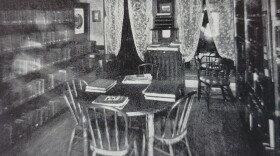Thomas L. St. Germaine was born in Lac du Flambeau in 1885. He was the son of Leon St. Germaine, who served as Chief Speaker for the Lac du Flambeau Band of Lake Superior Chippewa. Like many other First Nations children of the era, young St. Germaine was separated from his parents and sent to boarding school where he could be forcibly assimilated into white culture. No one went through the Indian Boarding School experience unscathed, but St. Germaine was able to use it to his advantage.
St. Germaine was sent to the Haskell Institute in Kansas. Included in the assimilation process were comprehensive sports programs where Indigenous children learned to play baseball, basketball, and football. St. Germaine excelled both academically and athletically, and after graduating from Haskell in 1900 he returned to his home at Lac du Flambeau. In 1907, St. Germaine enrolled as a student at the University of Wisconsin but found the atmosphere there less than welcoming. He left after less than a year.
St. Germaine moved east and enrolled at the Carlisle Dickenson College in Pennsylvania, which was a fortuitous move because the great Jim Thorpe was a student there at that time. In 1908, 1909 and 1910, Thorpe and St. Germaine played on the Dickenson football team together, with St. Germaine playing tackle.
After the two graduated, Thorpe went on to win gold medals in the 1912 Olympic Decathlon and Pentathlon. St. Germaine, on the other hand, enrolled at Howard and then Yale University, where he earned a law degree in 1914.
Getting employment in a law office was difficult for St. Germaine, so for the next few years he coached football at Villanova University in Pennsylvania. By 1920, however, he was practicing law in Mason City, Iowa, and that is when he got the call from Jim Thorpe.
The fledgling NFL got started in 1920, and in 1922 an Ohio dog breeder named Walter Lingo got the idea to start a team to market his dog kennels. After all, if a meat packer in Green Bay could do it, why not a dog breeder? Lingo founded a new team called the Oorang Indians in LaRue, Ohio. It was named for the Oorang Dog Kennels. Lingo hired Thorpe to be a player-coach, and Thorpe recruited teammates from his college days. In the days when ethnic minorities were barred from many sports, the Oorang Indians was a team comprised entirely of Native Americans. In addition to St. Germaine, who played center, there were two other players from Lac du Flambeau on the team. They were George Vetternack and Alex Bobidosh.
St. Germaine played only the 1922 season, after which he worked for the Department of the Interior at the Osage Indian Agency in Oklahoma. He returned home to Lac du Flambeau, and in 1931 was admitted to the Wisconsin Bar. St. Germain served as a tribal judge at Lac du Flambeau and defended Native Americans in state court while arguing for state judges to respect tribal jurisdiction. In the 1930s, he was instrumental in working with the Roosevelt Administration and the Indian Reorganization Act.
Thomas St. Germaine died of a heart attack in 1947.










